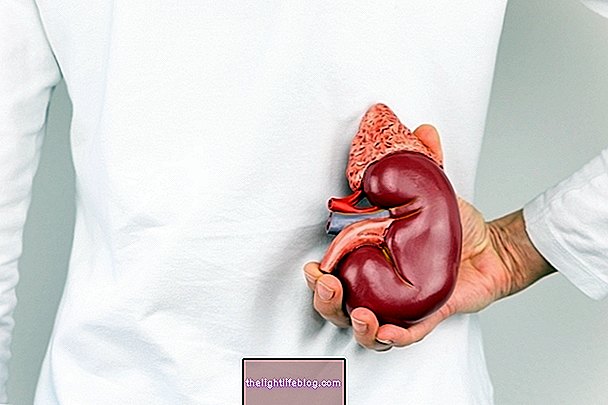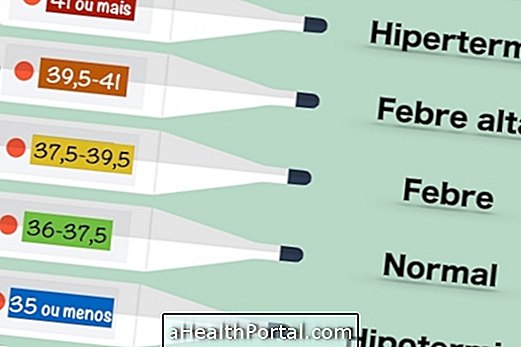Thrombotic thrombocytopenic purpura, or PTT, is a rare but fatal hematological disease that is characterized by the formation of small thrombi in blood vessels and is more common in people between 20 and 40 years old.
In PTT there is a marked decrease in the number of platelets, in addition to fever and, in most cases, neurological impairment due to the alteration of blood flow to the brain due to clots.
The diagnosis of PTT is made by the hematologist or general practitioner according to the symptoms and result of the complete blood count and blood smear and the treatment must be started soon after, as the disease is fatal in about 95% when not treated.

Causes of PTT
Thrombotic thrombocytopenic purpura is mainly caused by the deficiency or genetic alteration of an enzyme, ADAMTS 13, which is responsible for making the von Willebrand factor molecules smaller, and favoring their function. The von Willebrand factor is present in platelets and is responsible for promoting platelet adhesion to the endothelium, decreasing and stopping bleeding.
Thus, in the absence of the ADAMTS 13 enzyme, the von Willebrand factor molecules remain large and the blood stagnation process is impaired and there is a greater chance of clot formation.
Thus, PTT may have hereditary causes, which correspond to ADAMTS 13 deficiency, or acquired, which are those that lead to a decrease in the number of platelets, such as the use of immunosuppressive or chemotherapeutic drugs or antiplatelet agents, infections, nutritional deficiencies or autoimmune diseases, for example.
Main signs and symptoms
PTT usually shows nonspecific symptoms, however it is common for patients with suspected PTT to have at least 3 of the following characteristics:
- Marked thrombocythemia;
- Hemolytic anemia, since the formed thrombi favor the lysis of red blood cells;
- Fever;
- Thrombosis, which can occur in several organs of the body;
- Severe abdominal pain due to intestinal ischemia;
- Renal impairment;
- Neurological impairment, which can be perceived through headache, mental confusion, drowsiness and even coma.
It is also common for patients with suspected PTT to have symptoms of thrombocytopenia, such as the appearance of purple or reddish patches on the skin, bleeding gums or through the nose, in addition to the difficult control in bleeding from small wounds. Know other symptoms of thrombocytopenia.
Renal and neurological dysfunctions are the main complications of PTT and arise when small thrombi obstruct the passage of blood to both the kidneys and the brain, which can result in kidney failure and stroke, for example. To avoid complications, it is important that as soon as the first signs appear, a general practitioner or hematologist is consulted so that the diagnosis and treatment can be started.

How the diagnosis is made
The diagnosis of thrombotic thrombocytopenic purpura is made based on the symptoms presented by the person, in addition to the result of the blood count, in which a decrease in the amount of platelets, called thrombocytopenia, is observed, in addition to being observed in the blood smear platelet aggregation, which is when the platelets get stuck together, in addition to schizocytes, which are fragments of red blood cells, because red blood cells pass through blood vessels that are blocked by small vessels.
Other tests may also be ordered to assist the diagnosis of PTT, such as bleeding time, which is increased, and the absence or reduction of the enzyme ADAMTS 13, which is one of the causes of the formation of small thrombi.
PTT Treatment
Treatment for thrombotic thrombocytopenic purpura should be started as soon as possible, as it is fatal in most cases, since the formed thrombi can obstruct arteries that reach the brain, decreasing blood flow to that region.
The treatment normally indicated by the hematologist is plasmapheresis, which is a blood filtration process in which the excess of antibodies that may be causing this disease and the excess of von Willebrand factor, in addition to supportive care, such as hemodialysis, for example. example, if there is renal impairment. Understand how plasmapheresis is done.
In addition, the use of corticosteroids and immunosuppressive drugs, for example, may be recommended by the physician, in order to combat the cause of PTT and avoid complications.
Was this information helpful?
Yes No
Your opinion is important! Write here how we can improve our text:
Any questions? Click here to be answered.
Email in which you want to receive a reply:
Check the confirmation email we sent you.
Your name:
Reason for visit:
--- Choose your reason --- DiseaseLive betterHelp another personGain knowledge
Are you a health professional?
NoMedicalPharmaceuticalsNurseNutritionistBiomedicalPhysiotherapistBeauticianOther
Bibliography
- GOLDMAN, Lee; SCHAFER, Andrew I .. Goldman-Cecil Medicine. 25 ed. Rio de Janeiro: Elsevier, 2018. p. 1182-1183.


















